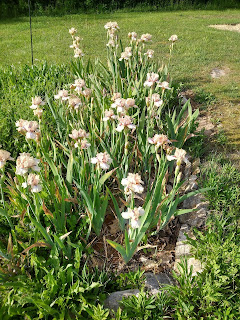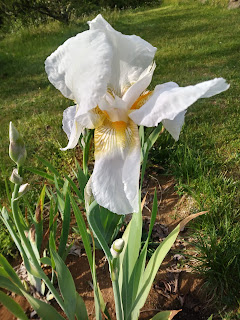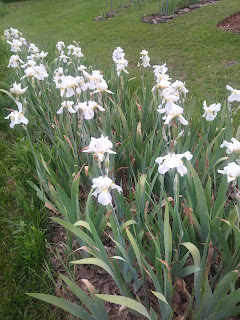Today we enjoyed the first blossoming of Irises of 2021, so the annual parade continues. In the past our blooming season was narrated by some of literature's most beloved stories, including J.R.R. Tolkien's, Lord of The Rings and Homer's Iliad. This year, we'll name our iris varieties after some of our neighbors down here in Lorraine Township, Huntingdon County, Pennsylvania. We'll use the blooming progress of the year to introduce some of those people (and animals) and tell some of their stories.
But if you'd like to read their stories, you can always check out my unpublished yet available for free on PDF novel. It is right here.
Because these neighbors are all here in a small, non-descript place you never heard of before, (or to be more accurate they lived here during some part of the past four hundred years, or some will be here in the next fifty years or so) it is the township itself that binds the story. This is not a quest narrative, unless you mean a kind of quest in which all of the characters have already become located right here. More a coming of age type of narrative group, but this time it is the coming of age of a township that believes of itself many ill fitting myths, mythology such as its self perceived lack of diversity and its self image of a place without a history worth uncovering. This is a mosaic of stories about a whole bunch of people who started out or ended up or came through the spaces which we now call Lorraine Township, a very true place even if its reality might be questionable.
First, let me help untangle what may seem to be a jumble of unconnected stories. I can assure you, they are all connected. Just as in human life itself, the clue to understanding one event may be contained in a passing conversation which happens in an entirely different time and place; we never learn all about someone or sometime all in one go, it comes to us slowly in dribbles. Also, all of the narrators are also themselves characters. So it is important to understanding the story for a reader to look for clues about who it is that spins that yarn and why they may be doing so.
First up, The Jordan Roberts Iris. It bloomed today (May 2) in a small clump between a couple of grape vines, almost never where you would expect to find her. More photos of The Jordan Roberts will be included here as her blossoms emerge during the next days and weeks.
Rudolf is a man with a son that is growing to be just too much like him in some ways and too much unlike him in others.
The Gregor Braun on May 18: Not to be confused with the similar Rudolf Braun iris, the Gregor is a bit bluer on the purple spectrum and does not have the thin cleft of purple in the white falls.

Gregor Braun was the youngest son of Rudolf and Matilda. Like most young farmers in the region, he spent his youth plowing, hoeing, cutting and hauling wood, planting beans, picking beans, and tending to animals. One day this young man had had just enough of Rudolf's tyranny and took to his feet. His initial plan was to head west and find some land of his own. His first night he spent at a nearby settlement of Native Americans where he helped repair a barn roof in turn for a place to sleep. From that night forward, they jokingly called him "Two Handles," for reasons that have not survived the rising fog of local history. Gregor made good time on his quest; earned his daily bread by doing chores for farmers along the way. But something happened that made him stop and turn back around. He went home, learned to speak French, inherited half of his parent's spread, founded the township, and became one of the gentry farmers of Huntingdon County, "Mayor Two Handles."
The Lorraine Braun on May 18
The township was named for her, yet Lorraine was not born here. Still, Jonathan supposed she was instrumental in insuring the township's most important landowner and founder ended up staying instead of leaving. Like "happy ever after" stories? This one's for you.
We first meet Lorraine just as Rudolf Braun happens by her front door in a small village called Philipsburg. But Jonathan knew, some two hundred years later, what Rudolf did not know right then on that afternoon: that Rudolf's youngest son had also been in that very front yard, just hours before the old man made an understandable if bad decision. Did Gregor know his old man was right behind him? I asked that question of Jonathan who lit a pipe and said, "dunno. But the little gift Lorraine gave to Rudolf, intending for it to be handed on to Gregor, is pretty compelling evidence that at least the girl knew Rudolf was Gregor's father. I'd bet they both knew."
The Germanica Irving Cullpepper first blossom of the season: May 19,2021
The Gemmy
Quite often Jonathan Fost joked that "the whole township turned on the love of Germanica." Then he'd usually snort and laugh at his own pun that nobody else seemed to ever get. Germanica is the
scientific name of the iris, which is why "Gemmy" was named Germanica. Gemmy's mother was the famed
Bess Irving who finally presented the fire engine red iris to the national society and won both the prize for
the discovery and it was named in her honor. But apparently that variety was only an instable hybrid. Within a few
years the bright red iris morphed back into this rusty red iris with the golden center named after Bess' daughter.
And it was for the love of this Gemmy, the person, that a young man, not from here in many ways, took up the project of
iris breeding, presenting Bess Irving with a "sure 'nuff" fire engine red specimen that could win the national
honors. Several years later this same young man would marry Gemmy, and their children would inherit most of
the most valuable lands in and around Lorraine Township. So it was both the love of Gemmy and for the
love of Germanica that the township would move. If you don't laugh at his little joke, it will be alright. Jonathan
has gotten used to that. Oh, yes. Every once in a long while, something in the genetic make up of this variety
of iris causes a specimen of the Bess Irving to show back up. Nobody has been able to stabilize the bright red cultivar
for long. But when someone is able to do that, it will probably come from Lorraine Township, again.
The Ellen opened on May 20
Our tallest iris, pure white with a golden center. This iris is a reliable variety that can be easily doubled each year.
Here is a bed of Ellen on May 25:
Thanks to the antics of my real third grade teacher, Mrs. Trailer, teaching in some place called Fyffe Alabama,
I am aware of the importance of watching for allusions in literature. As Mrs. Trailer would spring over
desks, in her full skirts, while pretending to spear Hector or raid the towers of Illium, she would warn us
to pay attention for clues in reading any literature. If there's a woman named Helen in the plot,
or a woman wearing a helmet, or someone throwing lightening bolts, you can bet they will be talking
about The Illiad, she told us.
So here is a story with a Helen, or at least with a name that came from the Greek word for Helen; this one, unlike Homer's Helen, was expressly stolen.
One in a thousand and wait 'till you see her photograph! (It is in the PDF of the Novel. She is standing like Venus, out in the yard wearing nothing but a halter!)
The Alexander Hamilton blossomed on May 23
Alexander Hamilton is probably my most autobiographical of characters. He appears on the scene at a low point for his family one day when Rudolf looks up from his bean planting and sees the starving
mule colt walking upstream beside the small creek called Yellow Spring Run. His mother, long gone at
that point, was one of those Federal mares, ridden here by a major in the Army assembled to put down
the whisky rebellion. Her breed was Kentucky Mountain Horse, but she was raised near the city;
so she had a particular weakness for that wild backcountry jackass type, like the ones being raised
on Canoe Mountain in Indian Town. Alexander Hamilton's sire lived over on Canoe Mountain, one
of many unnamed donkeys roaming the mountainside there; and he soon passes out of remembered
history. But Alexander goes on to join the Braun family and was famously standing by on the day that
Matilda Braun shot off Rudolf's ear. Year's later, old Hamilton died rather suddenly, pulling a too
heavily loaded wagon full of logs that had become stuck in the wet clay bank of a creek, just a
matter of feet away from where he was found as a colt. The fourteen year old Quaker boy who
had been driving the wagon ran home for help. But when they got back to him, old Hamilton was
already dead, apparently his heart burst while still trying to pull that cart out of the mud.
The Ptesan-Wi blossomed on May 23:
Ptesan-Wi, later "Tess," almost never talked. While she supposedly spoke with her sons from time to time, this was usually the utterance of one word supported by a long series of gestures. For Tess verbal communications seemed an unnecessary pastime.
At a very young age, as a runaway from federal marshals who were scouring the hillsides for her and two other runaways, she moved into a tumbledown stone hideout of the notorious Simon Gannister. Still in her teenage years when she started giving birth to sons, (first Si and then Henry), Tess's neighbors, those who knew she existed anyway, generously began calling her Simon Gannister's wife. The truth was even a darker secret. Tommy Talon, one of the two co-runaways had grown to be her lover and common-law husband. That young man fathered both boys, as it turns out, but was himself the target of Simon Gannister's aggressive predation. Simon continued to keep Tess and the boys hidden out at his hideout, just to insure that this other young man, probably the only human on Earth that Simon ever cared for, would stay close to him. Tess was a kind of insurance policy for Simon.
The story of Simon's capture and death at the hands of the posse has many internal contradictions. The posse spent the morning shooting from behind rocks on the south side of the river and Simon was found dead, it turned out to be a stab wound, at the top of the hill on the northern bank. This has led many an objective historian to the conclusion that Simon had already evaded the posse by escaping over the hill behind his hideout, up there where he kept his horses. But when he crawled up that hidden path and right at the point where he would have come to the top to take a standing position again, someone planted a knife directly in his chest. That someone would have known to expect Simon and would have known of the escape pathway. I believe that someone was Tess, because her actual lover and the genetic father of her young children she called "Iktomi" had been taken by the posse earlier in the day and happened to be already in jail, awaiting his hanging in the public Williamsburg square much later that evening. Tommy was accused of being in the Simon Gannister "gang," tried at a bonfire in front of the town hall, and executed sometime around midnight.
After the inquest, when the local elected judge returned most of Simon's ill gained lands and wealth to his own friends and neighbors that he declared the rightful owners, Tess and sons retained only a small mountain of granite and limestone. At the time this was considered worthless land, a place that could not even grow beans. Tess and her sons would turn that mountain of stone into the township's only goldmine, benefitting from the appetite for trackside firewood and then crushed stone by the growing railroad. Later, the expansion of the national highway system, and its need for an infinite supply of crushed gravel, expanded the business beyond what even its youngest founder could ever have imagined.
Who was Tess and how did she end up here in Lorraine Township are whole 'nother stories unto themselves.
The Asta Beek bloomed on May 24
A survivor. Born in Manhattan, sold to some slave traders while still in her late teens, Asta died on Freedom
Mountain, an outcropping of tumbled stone located at the point where the Little Juniata River is joined
by the Frankstown Branch. She died after almost thirty hours of what she would have called "birthin
labor" after a year long cross wilderness trek with a man she really never knew. Her baby would
be raised by that man in a woodland populated by several villages of Native Americans and one
escaped Irish indentured servant.
The Gretchen Gannister opened on May 24
Gretchen was Tilde Fost's mother, Jonathan Fost's wife, Pap's granddaughter, and the organizing motive
force for the Gannister Brother's Aggregate Company operations. She figured she could wish happiness
into existence by a steadfast determination to be and to remain happy. And she seems to have been
happy; happy right up to the last six months of her life.
The Henry Gannister a/k/a "Pap" blossomed on May 25
The Si Gannister bloomed on May 25:
The Larry Nesbit bloomed on May 25
Larry is my muse of wisdom about whom you will learn as he narrates and is narrated. Born just a few miles away from where Jonathan is from, Larry Nesbit got his professional start on a horse drawn cart with his Grandfather. As they pulled through Baltimore residential neighborhoods, Larry remembers his grandfather singing "Top Soil, Toooop Soil" in one direction and then in the other direction he would sing, "lawn leveling. We level your lawn." When Larry was eight years old he looked up at his Grandfather and said, "you get that top soil from those lawns, don't you?" His Grandfather just pulled Larry's hat down over his eyes and laughed. This lesson Larry never forgot.
The Mick Berger bloomed on May 25
Note: Mick is the author's favorite character. Born on December 6, 1959, he plays the role of the muse of TRUTH. And that role takes courage. It's easy to tell the truth when the world wants to hear what you have to say and when everyone believes you. Courage is required to tell the truth to a world that would rather not have its presently held notions contradicted by new information. Of course, as we learned from Kant and Hume, what we presently believe about the world will conspire against our human abilities to accept and process any new information. If they are right, how on earth do we ever learn anything new? This problem kept Jonathan Fost awake at night.
For thousands of years the Greek World believed Hesiod. The Hebrews believed David. The Moslems believe their Prophet. And Christians believe the Gospel writers. One of the greatest story tellers of all time, a holy man named Vyasa, is believed by most Hindus. Why do some people believe in some explanations for things and yet nobody believes Mick? Not to be confused with _Theogony_ a poem by a shepherd named Hesiod, here is the first of three chapters of an epic poem as relayed to Jonathan Fost by Mick Berger.
The Benjamin Talon bloomed on May 25


Benji Talon was the son of a long line of locally prominent lawyers and judges. When he first graduated from Law School he landed a job with a firm in Harrisburg, married a girl whose father was the managing partner and that almost ruined his life. So he got a divorce, quickly took another job, and created a specialty in immigration law while living near Berlin in Germany. There he met the love of his life one morning as she walked into the room, already engaged to another, in her third trimester of pregnancy. Everything she owned in the world was packed in a too large backpack she had with her in the law office. To hear Jonathan Fost tell the story, Benjamin proposed to her in front of her then intended, while sitting there at the conference table in the law firm's least expensive meeting room. More amazing than that story is the ending. Supposedly, Lena said yes to Benjamin immediately, with the confused history teacher previous fiancé, yet not the father of her child either, congratulating the two of them before hugging Lena once more, shaking Benjamin's hand, and then departing the law office to catch his train. Watching that history teacher bolt out of the glass walled conference room, you'd almost get the idea that he was much relieved.
The Ludwig Lukenbach, a/k/a "Simon Gannister" bloomed on May 28:
You've been patiently awaiting The Lena Roscha (my muse of beauty.) She bloomed May 28:






.jpg)



.jpg)






.jpg)
.jpg)


















































